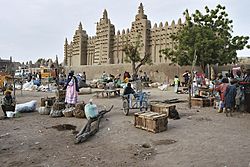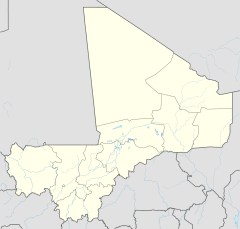Djenné facts for kids
Quick facts for kids
Djenné
|
|
|---|---|
|
Commune and town
|
|

Street market and the Great Mosque of Djenné
|
|
| Country | |
| Region | Mopti Region |
| Cercle | Djenné Cercle |
| Area | |
| • Total | 302 km2 (117 sq mi) |
| Elevation | 278 m (912 ft) |
| Population
(2009)
|
|
| • Total | 32,944 |
| • Density | 109.09/km2 (282.5/sq mi) |
Djenné (also called Djénné or Jenne) is a historic town in central Mali, a country in West Africa. It is located in the Inland Niger Delta region, near the Bani River. Djenné is known for its unique buildings made of mud, especially the famous Great Mosque.
The town is an important administrative center. It is the main town of the Djenné area, which is part of the Mopti Region. In 2009, Djenné and its ten nearby villages had a population of 32,944 people. Djenné, along with an ancient site called Djenné-Djenno, became a World Heritage Site by UNESCO in 1988.
Contents
History of Djenné
The story of Djenné is closely connected to the famous city of Timbuktu. For many years, from the 1400s to the 1600s, Djenné was a very busy trading hub. Many valuable goods, like salt and gold, passed through Djenné on their way to and from Timbuktu. This trade was part of the larger trans-Saharan trade network that crossed the Sahara Desert.
Both Djenné and Timbuktu also became important places for Islamic learning. Scholars and students came to these cities to study. However, when the Portuguese started setting up trading posts along the African coast, the old desert trade routes became less important. This caused Djenné's importance as a trading center to decline.
Amazing Architecture
Djenné is famous for its special style of building, known as adobe architecture. This means buildings are made from sun-dried mud bricks. The most well-known example is the Great Mosque of Djenné. The current mosque was built in 1907 on the site of an even older mosque.
The buildings in Djenné have a distinct look, with tall, impressive walls and pointed towers. Many houses feature beautiful designs on their fronts. This unique mud-brick style helps keep the buildings cool in the hot climate.
Djenné-Djenno: An Ancient Site
Just south of Djenné is an archaeological site called Djenné-Djenno. This site is very important because it is one of the oldest known towns in sub-Saharan Africa. People lived there as early as 250 BC. Studying Djenné-Djenno helps us understand how ancient communities in this part of Africa lived and developed.
Images for kids
See also
 In Spanish: Djenné para niños
In Spanish: Djenné para niños









